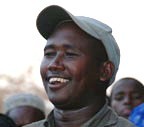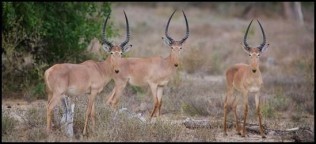Born into the Samburu tribe of northern Kenya, Tom Lalampaa could have ended up following the traditional pastoral lifestyle of his people – had his brother made a different choice. When Tom was a child, his father called his sons to him and said, “I’d like one of you to go to school and the other to remain here and help take care of the cattle.” The decision fell to Tom’s brother, as the eldest. He opted for the cattle, and Tom was sent to school. Ultimately – with the support of the entire community – he went on to complete a BA in social work and an MBA in strategic management at the University of Nairobi.

As it turned out, his brother’s choice wound up changing not only Tom’s life but also that of the Samburu community and the land they call home. As community development manager for the Northern Rangelands Trust (NRT), Tom is now a key player in efforts to protect Kenyan wildlife and improve the lives of his people and others who inhabit this beautiful but often unforgiving place.
The savannas of northern Kenya abound with wildlife, including several endangered species, notably the Grevy’s zebra (only about 2,500 individuals remain in the wild, the majority of them in Kenya) and the Hirola antelope (whose wild population is probably no more than 400 animals, making it Africa’s most endangered antelope). Yet problems have been widespread: poaching of elephants for ivory, the killing of a variety of species for bush meat and cultural reasons (wearing lions skins is a key part of traditional ceremonies), and general environmental degradation from human use and migration. Add to that a porous border with the Sudan to the north and a high level of conflict and mistrust between different ethnic groups in the area, and you have a region where conservation challenges have long outweighed successes.
Since 2004, however, all that has been changing. That’s when the nonprofit Lewa Wildlife Conservancy joined with representatives from the Kenyan government and local stakeholders including private and community conservation initiatives to create the Northern Rangelands Trust. Formed to coordinate previously fragmented conservation efforts and promote cooperation rather than conflict between different ethnic groups, the NRT is “a home-grown institution aimed at addressing home-grown problems and creating long-lasting local solutions,” according to its website. It unites different interest groups “with a goal of collectively developing strong community-led institutions as a foundation for investment in community development and wildlife conservation.”

The NRT links conservation and development through community conservancies, which are community-led initiatives that work to meet conservation goals in ways that also benefit local residents. Conservancies engage communities in conservation efforts and natural resource management while simultaneously developing wildlife-based sources of income.
Since the establishment of the NRT, “security in northern Kenya has greatly improved,” Tom Lalampaa says. “Security for people, and security for wildlife.” Local conservation staff are now equipped with VHF radios, enabling them to report violations or other problems quickly. Increased communication between ethnic groups has greatly reduced intertribal conflicts. “Eight different ethnic groups are getting to work together, plan together, and to trust each other,” Tom explains.
On the conservation front, NRT successes have included improved grassland management (benefitting both wildlife and livestock) and an intensive aerial survey of the Hirola antelope population (efforts are now underway to secure funding to develop a predator-proof sanctuary to safeguard a breeding population of the species). The organization was also instrumental in the recent reintroduction of the endangered Rothschild’s giraffe to areas where it had not been seen for 40 years – an effort that involved a dramatic and complicated transfer of eight giraffes on a barge across Lake Baringo to a community-owned wildlife sanctuary on the opposite shore.
In the past, conflict has kept most tourists away from northern Kenya, but now visitor numbers are increasing. Six community-run lodges provide revenue for community development, and other tourism-related enterprises are taking root. Many local women have received microloans to establish businesses making and selling handicrafts. Traditionally wealth was concentrated in the hand of the men, but now, Tom says, “the dynamics are really changing. Women are getting their own resources, their own voice.”
Other community development initiatives have included cutting out middlemen in order to enable locals to command higher prices for their cattle, and building a water pipeline to save women from having to walk for hours every day to fetch water. Educational opportunities have also increased: In 1990, Tom was the only person from his village to go to university; now there are 43 students from the community pursuing higher education.
“When I look back to where we were some time ago in the community to where we are now, it’s amazing,” Tom reflects. “People are now seeing wildlife as a resource and taking responsibility for their lands. There is dialogue where there was conflict.”
A recent study of NRT conducted for The Nature Conservancy by researchers at the University of Southampton supports these claims. The researchers found that “[c]ommunity conservation has significantly enhanced both livelihoods and habitat condition in northern Kenya” and concluded that “community conservancies may provide a framework for integrating conservation and development at the local scale.”
The NRT currently supports 18 community conservancies that protect 2.4 million acres (971,000 hectares) of land, with more communities clamoring to join. Ultimately, Tom dreams of having 10 million acres of land in conservation. It’s a big goal, but he is undaunted: “I look at my past, I look at where I am, and I look at where I’m going, and I think the future is bright.”
Read Ethical Traveler's Reprint Policy.
